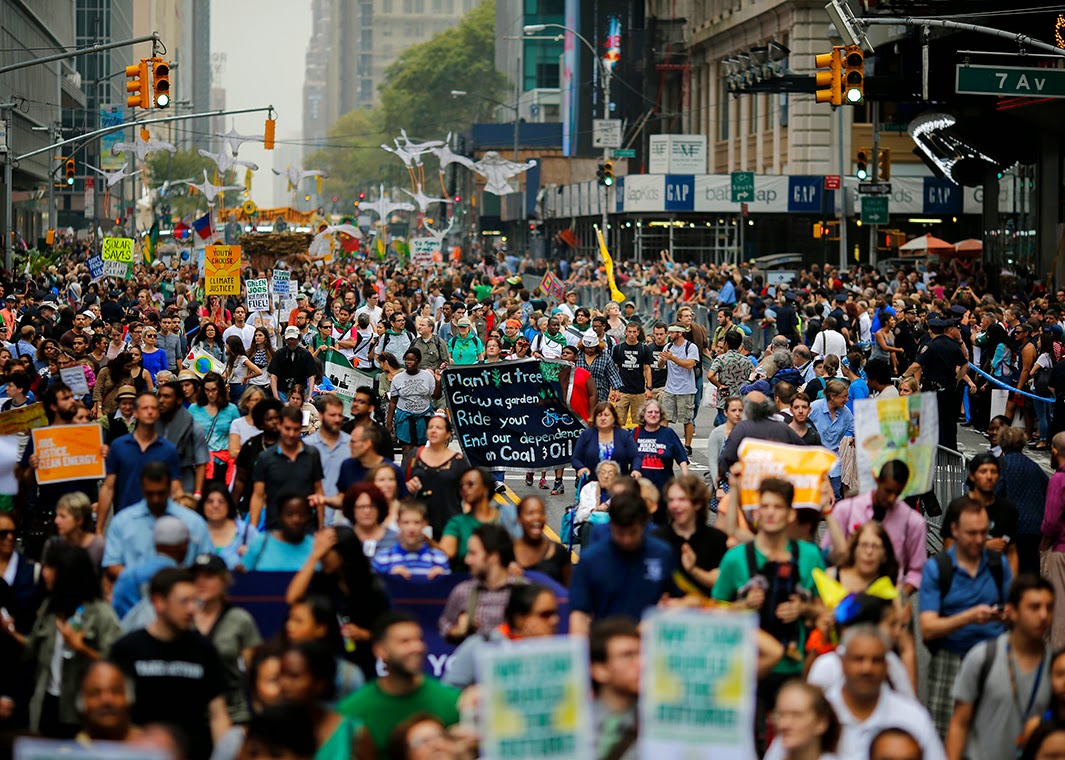Saturday, September 27, 2014
Peoples' Climate March: Prelude to the Mother of all Movements?
Geeta and I joined the amazing People's Climate March in New York last Sunday. We marched with Quakers amongst the faith communities, a cohort with a pre-march estimate of 10,000, rivaling Labor as the biggest bloc. Over 300 Quakers showed up, positioned next to the Unitarians. This march, carefully planned and brilliantly executed, was billed as a watershed event for the climate movement. Whether or not this will prove to be the case, we will know soon enough. As many have said, including the International Energy Agency, we are now in “decade zero”; it's now or never. The immediate goal is to sign an international climate treaty under UN auspices at COP 18 in Paris next December to replace the fading Kyoto Treaty.
The large faith contingent was to gather on a side block, joining the march at the appropriate time. We waited well over three hours for this moment to arrive, with those who arrived early for Quaker-style silent worship to bless the effort waiting much longer. The entire march was aksed to observe a minute of silence in honor of those who have already lost their lives to climate change. I would say the partial silence lasted less than 15 seconds. Believe me, there is not much silence when 310,000 put on their boots and take to the streets! While we waited, we had prayers and a lot of rallying songs and hymns from the speaker trailer up front. True to form, the Hari Krishnas next to us drummed and danced with such cacophany that the loudspeakers couldn't dint them. I hope Krishna heard, because we couldn't. Next to them were middle class South Asians, also gathered beneath the neat little pennant reading “Hindu.” This was a Big Tent affair, so the mainstream faith communities were joined by groups like ethical humanists, atheists, and “New Thought.”
The march began in Central Park and wound its way through the streets, right through Times Square, to 34 Street and 11th Avenue. At one point progress of the march was halted, because the entire route, 80 city blocks, was filled. We were making a statement, amplified by some of our onlookers, including a large group of meditators in a park along the route and the Bard Grad School, who egged the crowd on to huge roars beneath their strategic quarters about eight stories up on 42nd Street near Times Square.
The gargantuan rally coincided with the announcement of fossil fuel divestment by the Rockefeller Foundation, who some speculated may have bankrolled the PR for the march. Other companies also announced divestment that day. A high official from the World Bank said before the week began that folks were “going to be surprised” at how many corporations and various regional political unions, as well as provinces and municipalities, were lining up behind a carbon tax.
However, on Tuesday, given their chance to answer Ban Ki Moon's call, national leaders ducked, waiting, as usual, to see what commitments other nations might make. Many on the Left, notably Chris Hedges, dismissed the march as a huge greenwashing stunt by corporations, orchestrated by the U.N., and the lack of commitment on Tuesday gave these arguments a depressingly prophetic air.
Subscribe to Comments [Atom]


